Powerpoint presentation
Council on Aspirin
Health and Prevention
National Commission on Prevention Priorities:
In 2007, the Partnership for Prevention-convened National
Commission on Prevention Priorities published a new study ranking
those community preventive services that provide the greatest
impact and are the most cost-effective. The research concluded that
utilization rates remain low for many preventive services that are very
cost-effective and save lives. The Commission determined that
counseling about regular aspirin use was one of the top-ranked
clinical preventive services based on value and impact.
NCQA/HEDIS measure: 2008
Partnership for Prevention and the Aspirin Task Force worked with the
National Committee for Quality Assurance to develop an aspirin quality
measure for health plans. Task Force members Dr. Michael Pignone, Dr.
Randall Stafford, and Kathy Berra served as the aspirin experts. The process
began in 2008 and the measure was added to the Healthcare Effectiveness
Data and Information Set (HEDIS) in 2010. Through a consumer survey, the
aspirin quality measure assesses the fraction of men aged 46-79 and
women aged 56-79 enrolled in commercial plans who have discussed the
benefits and harms of aspirin with their health care provider. Today, CAHP
members continue to be involved in NCQA CVD prevention guideline
Medicare National Coverage Determination: 2010
In 2010, Partnership for Prevention and the Council on Aspirin for
Health and Prevention submitted a National Coverage Determination
request to the Centers for Medicare & Medicaid Services (CMS). It
asked that health care providers be reimbursed for talking to patients
about taking aspirin to prevent heart attack and stroke. CMS reviewed
the request and the evidence behind aspirin counseling and agreed,
creating an "intensive behavioral counseling for cardiovascular
disease" benefit to reimburse providers. Partnership for Prevention
received the Health Policy Award from the National Forum for Heart
Disease and Stroke Prevention for this work.
Online Aspirin Advice Tool: 2008
Randy Stafford, MD
Dr. Stafford developed an online tool that advises consumers about
whether aspirin is right for them and facilitates patient-provider
discussions about aspirin. It was pilot tested among Stanford
University employees. Data collected through the online tool
showed that of patients without past stroke or heart attack who
were most likely to benefit from aspirin, only 56% were taking
aspirin. Of those with little to gain from aspirin, 11% were
nonetheless taking aspirin. The tool advised users to speak with
their health care providers, particularly when the recommendation
for use was different from their current practices.
Aspirin for Primary Cardioprevention: 2009
Dr. Miser conducted a detailed clinical survey of aspirin use in five
family medicine practices in the Ohio State University Primary Care
Network. A total of 1,615 subjects, age 40 to 79 years, were asked
about their cardiac risk factors, patterns of aspirin use, and
interactions with health providers about aspirin. The most common
reasons for not taking daily aspirin were that no one recommended it
(32%), already taking too many medications (13%), concern about
interactions (9%), bleeding problems (8%), and aspirin allergy (5%).
The survey showed that discussions between patients and clinicians
were key to decisions to start taking aspirin.
Aspirin Cost Effectiveness: 2010
Michael Pignone, MD
Dr. Pignone published an article on how cancer mortality affects the cost-
effectiveness of using aspirin to prevent first heart attacks in men.
Modeling a hypothetical population of middle aged men without diabetes
or heart disease who were given aspirin therapy, he estimated their
decreased risk of cardiovascular disease and cancer compared with the
increased risk of gastrointestinal bleeding and stroke. Accounting for both
cardiovascular and cancer prevention benefits, aspirin was cost-effective
for middle aged men with a 10-year chance of developing cardiovascular
disease as low as 2.5%. This expanded the population in which aspirin
benefits exceeded harms. This analysis suggests that aspirin
recommendation should not be based solely on cardiovascular disease, but
rather should incorporate cancer prevention.
A Survey of Aspirin Use in the USA: 2012
Craig Williams, PharmD
The Council on Aspirin for Health and Prevention conducted a
national survey of U.S. adults on aspirin use to update a previous
survey conducted in 2006. 2,509 adults aged 45-79 were asked about
their current aspirin use, their knowledge of aspirin's benefits and
harms, and whether they discussed taking aspirin with a health care
provider. Of those without a history of cardiovascular disease, 47%
reported using aspirin. Aspirin use was more common if risk factors
for heart attacks and stroke were present. In addition, those surveyed
were more likely to use aspirin if they were more knowledgeable
about aspirin's benefits and harms and if they had discussed aspirin
use with their health care providers.
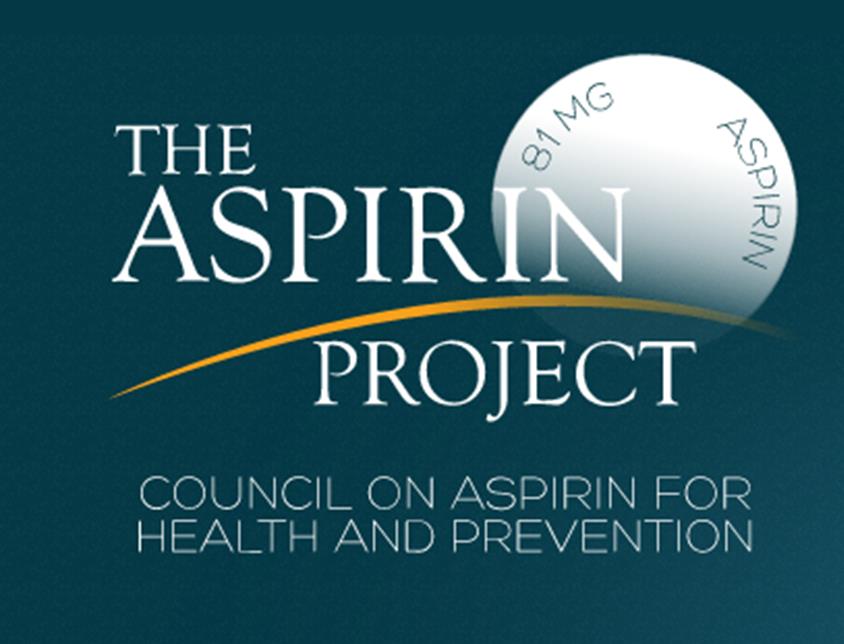
Aspirin Project Brand Developed: 2013

www.aspirinproject.org: 2013
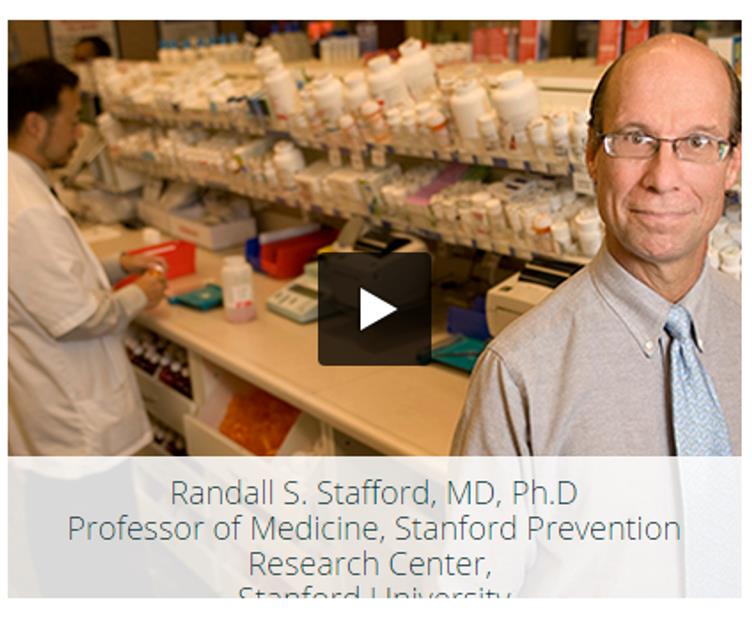
Video - "Who Should Take Aspirin?": 2013

Video – "Aspirin and Cancer Prevention": 2013
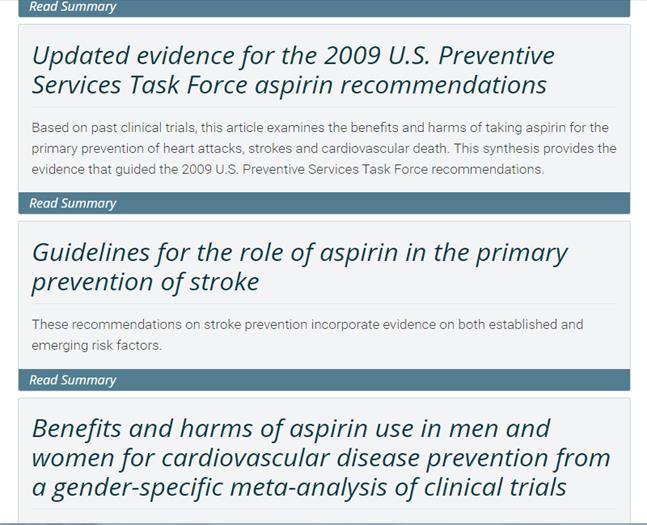
Key Evidence Summaries: 2013
The Aspirin Project maintains a repository
of key evidence related to aspirin and
prevention. The key evidence articles
feature most of the critical research
studies in recent years that inform national
aspirin use guidelines and
recommendations.
Fact Sheets: 2013
◦ Council on Aspirin for Health and
◦ Aspirin's Revolution: Folk Remedy to
◦ Men and Women: Protecting Our
◦ Experts Say Aspirin is Lifesaving ◦ Aspirin and Primary Prevention:
Benefits and Harms
◦ Should I Prescribe Aspirin for Primary
Prevention in My Patients?
Aspirin in the News: 2013
Each month, the Aspirin Project
publishes a two-page digest called
Aspirin in the News, highlighting
recent consumer-friendly and
scientific articles of significance.
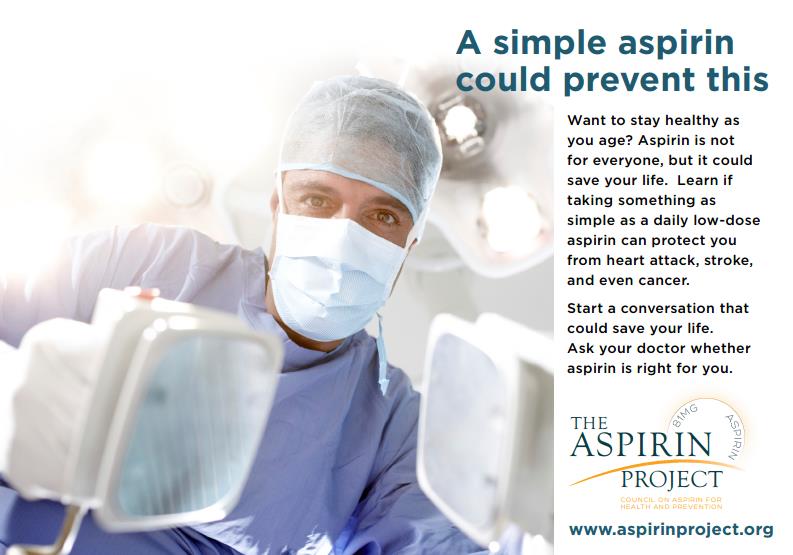
Downloadable Aspirin Ad: 2014
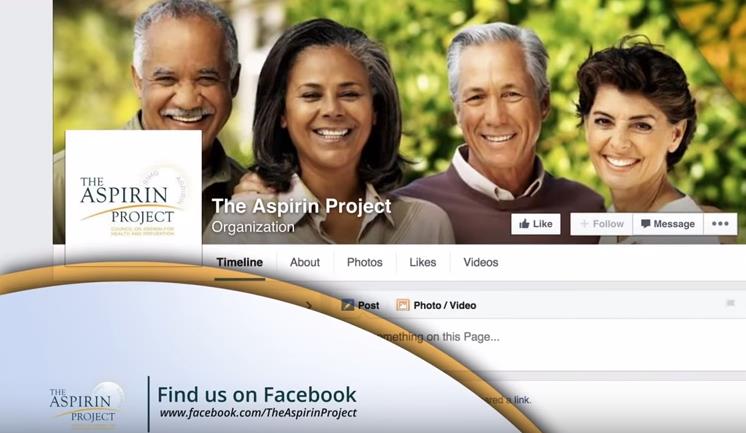
Aspirin Project Facebook Page: 2014
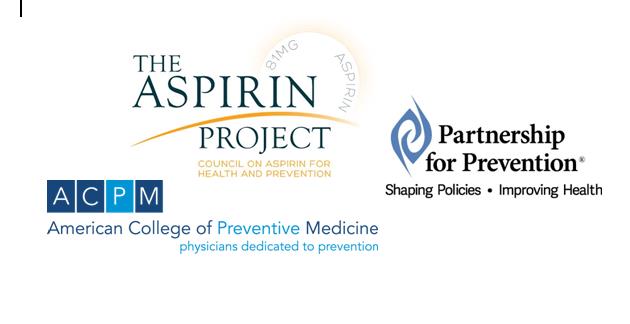
Educational Program: 2014
Aspirin & Disease Prevention: A Clinical Perspective
Aspirin Project Promo Video: 2014
Aspirin Grants to External Organizations: 2015
The Council on Aspirin will award
grants up to $10,000 for the
implementation of projects to
increase the appropriate use of
low-dose aspirin. Funds may be
requested for educational,
communications, implementation
science, and/or partnership-
building activities that relate to aspirin and disease prevention.
New Council on Aspirin Research Project: 2015
The Council on Aspirin awarded a grant to Russell Luepker, MD,
University of Minnesota School of Public Health. The project, titled
"Testing a Community Intervention to Increase Aspirin Use for
Primary Prevention of Cardiovascular Disease," will develop strategies
to improve the appropriate aspirin use in an underserved
Hispanic/Latino community utilizing a Community Based Participatory
Research approach.
"Ask about Aspirin" Program
Ask About Aspirin
Ask About Aspirin's goal is to support the State of Minnesota Heart Disease
and Stroke Prevention Plan by lowering the number of first heart attacks
and strokes with the usage of low-dose aspirin. The initiative was designed
by the Lillehei Heart Institute at the University of Minnesota Medical
School, in partnership with the School of Public Health, and is an official
partner of the U.S. Department of Health and Human Services Million
Hearts ® initiative. In 2015, less than one in three at-risk Minnesota adults
use daily low-dose aspirin to lower their risk of a first heart attack or stroke.
Appropriate primary prevention aspirin use has the potential to prevent
more than 10,000 first time heart attacks and strokes in Minnesota.
Ask About Aspirin Banner
Ask About Aspirin Goals
Conduct research to explore general public knowledge, attitudes,
and behavior related to aspirin.
Launch a healthy living campaign to promote best practices in
Safely lower rates of first heart attacks and strokes.
Facilitate effective population health across Minnesota.
Ask About Aspirin's desired action on the part of the public is for men
and women in the targeted age groups to consult their health
professional to ask if they should take aspirin. The action desired on
the part of health professionals is for them to evaluate their patients
about the use of aspirin for cardiovascular disease prevention and
recommend it to those for whom it is appropriate. The program is
both a public health campaign, devoted to increasing aspirin use in the
target population, and a clinical investigation, to determine the
relative efficacy of each key intervention - public media campaign,
social media messaging, and health system intervention.
Ask About Aspirin Posters
Focus Group and Survey Findings
6% had already had either a heart attack or stroke.
55% had already been taking aspirin.
78% believed taking aspirin has advantages; only 3 percent said it
has disadvantages.
95% said their doctor could convince them to take aspirin. Of those taking aspirin for prevention, 79% take low-dose aspirin.
Hibbing, Minnesota Pilot
Hibbing, Minnesota, was selected for the community-based
intervention, a city of approximately 16,000 persons. At baseline, 36%
of the primary prevention candidates reported regularly using aspirin,
which is comparable to the national average. After a continuing
medical education campaign for health care providers and a mass
media campaign to reach consumers, the following positive results
At 4 months, the percentage in the intervention population who reported
regularly using aspirin had increased to 54%. This was sustained at 52%
at the 16 month mark. Additionally, at 4 months, 46% of primary
prevention candidates, and at 16 months 63% of candidates, indicated
they had seen or heard the program messages in their community or
workplace.
Now, as the Ask About Aspirin team attempts to take the initiative
statewide in Minnesota, several aspirin-related practice tools are
being made available free of charge. These include a short "state of
the art" web-based CME accredited learning module, a patient
brochure, an electronic health record tool, and a clinician information
sheet. Aspirin rates for the primary prevention of cardiovascular
disease in Minnesota remain low, but a combined public health and
primary care approach, through the delivery of a community-based
intervention, may offer an effective and relatively rapid means to
increase and sustain aspirin use rates for primary prevention.
Source: http://www.nationalforum.org/sites/default/files/Zauche%20Nat%20Forum%20aspirin%20presentation%20PDF%2010-21-15.pdf
ACUPUNCTURE AND TENNIS ELBOW About tennis elbow Tennis elbow (lateral epicondylitis) is characterised by pain and tenderness over the lateral epicondyle of the humerus. In the UK, the annual incidence of lateral elbow pain in general practice is around 4/1000 to 7/1000 people.(Hamilton 1986) It is most common in people aged between 40 and 50 years (Allander 1974); for example, the incidence is as much as 10% in women aged 42 to 46 years.(Chard 1989; Verhaar 1994)
Anova Health Institute, November 2013 Recommended Citation: McIntyre, J., Jobson, G., Struthers, H. De Swardt, G., Rebe, K. Rapid Assessment of HIV Prevention, Care and Treatment Programming for MSM in South Africa. Assessment Report 2013, Anova Health Institute, Johannesburg. Available at: http://www.anovahealth.co.za The Anova Health Institute acknowledges the assistance of the fol owing people in the preparation of this report: Candice Harrison-Train and Carmel Marock of Singizi Consulting, Anne Aslett and Mohamed Osman of the Elton John AID Foundation, Tim Lane, Zach Isdahl and Alex Marr of UCSF and all the respondents who so willingly contributed their expertise.







